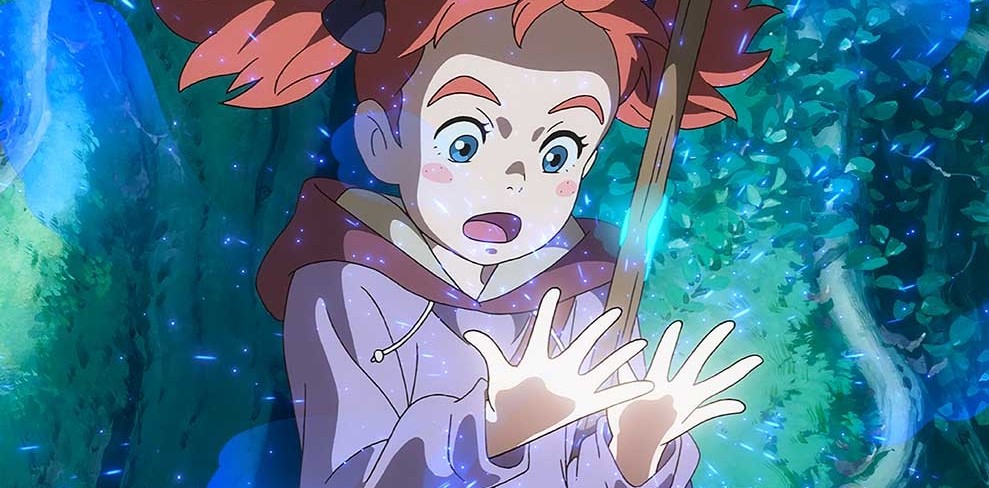Ghibli guys go it alone
As a fan of the Studio Ghibli output, it’s exciting to learn that a few disciples of Miyazaki and the late Takahata have stepped out to form their own animation studio: Studio Ponoc. Their first feature, Mary and the Witch’s Flower, is an adaptation of British children’s book ‘The Little Broomstick’ by Mary Stewart.
The story follows a young girl, Mary, who is living with her Great Aunt in the countryside, but when she stumbles across a rare, wild flower, she is given the power to be a witch for one night. The screening I was at for this was subtitled rather than dubbed, but the dubbed version has Jim Broadbent if that floats your boat at all.
For anyone who has indulged in Ghibli films over the last few decades, a lot of the imagery and themes will feel very familiar in this film. It’s probably to be expected that the art style is the same, and that is a huge bonus because there are few studios out there operating on such a level, it’s crisp and defined when it needs to be but can easily switch to a mode which adds depth and whimsy to the surrounding world. Clearly a Japanese animation about a young witch, struggling to fly her broom, will draw comparisons with Kiki’s Delivery Service, but there are also parallels to be drawn with Spirited Away (a sulky child and a mean madame), Howl’s Moving Castle (magic and an anthropomorphised flame) and Ponyo (bubbles, blobby creatures and red haired girl) – even the fact that they’ve chosen a British book to base it on is a classic Ghibli move.
Aside from that borrowing streak, director Hiromasa Yonebayashi – who directed Ghibli’s When Marnie Was There and The Secret World of Arrietty – does a good job of taking his knowledge to this new studio. He’s a steady pair of hands with which to build a foundation around for this first film, bringing warmth to characters and a sense of wonder to the world.
What’s jarring about the film, despite my preference to go for the subtitled version most of the time, is how British names are pronounced by the Japanese voice actors. Peter comes out as “Petuoh” and Mary Smith is “Meari”, and while that might seem a small and insignificant thing, it was something that took me away from the story at key points.
‘It is great to see Studio Ponoc stick with a female protagonist, continuing Ghibli’s great work to throw off the idea that girls should be passive’
While Yonebayashi is good choice to helm this project, coming away afterwards I couldn’t help feel there was just a little something missing. Perhaps it is the harsh way in which you automatically compare this to Miyazaki’s work, but it just seems to fall short of that splendid and enchanting wonderment. He’s sure of the spirit, but I wasn’t warmed by this tale in the way I think they intended.
Mary as a character is set up as clumsy, but not lacking in adventure, this is not quite the same as Chihiro in Spirited Away, who underwent a whole change in her perspective to find her adventurous spirit and embrace the unknown – which is one of the things that makes that film so brilliant. Mary, on the other hand, goes on a big adventure, but the message seems a little more simplistic than a Ghibli one: everyone has the ability, you just need the confidence. Again though, this is a criticism through comparison, which might seem unfair, but you have to accept that this film has essentially been done before, and better. It is great to see Studio Ponoc stick with a female protagonist though, continuing Ghibli’s great work to throw off the idea that girls should be passive and let the boys do the heroics (something Disney have taken note of in recent years).
As you’d expect, the animation is a treat for the eyes, with the English countryside rendered beautifully in hand drawn backgrounds. The magic has that same sputtering, firework glow you’d expect and the animals – particularly the cats – are kept cute. The central antagonists, Madame Mumblechook and Doctor Dee, are characterised to match their greed, but seem to be held back from being truly formidable and terrifying foes through their actions. Peter, Mary’s friend, is an annoying character but thankfully isn’t around too much, while Flanagan – the caretaker of the brooms and a mustachioed mouse-like creature – is sure to be a fan favourite.
If you’ve read the book, or had it read to you, I’d be keen to know how well the film follows the book. From a quick rummage around the internet it does seem to have the same focus and basic plot points, which could have something to do with the limited impact the story has on you. I would certainly see this again, mainly because the animation is so stunning, but also because there is probably more to be gleaned from a second viewing of a film like this. I’d say it’s suitable for small children, but some of the strange goings-on might confuse the very young, despite the ‘U’ rating.
